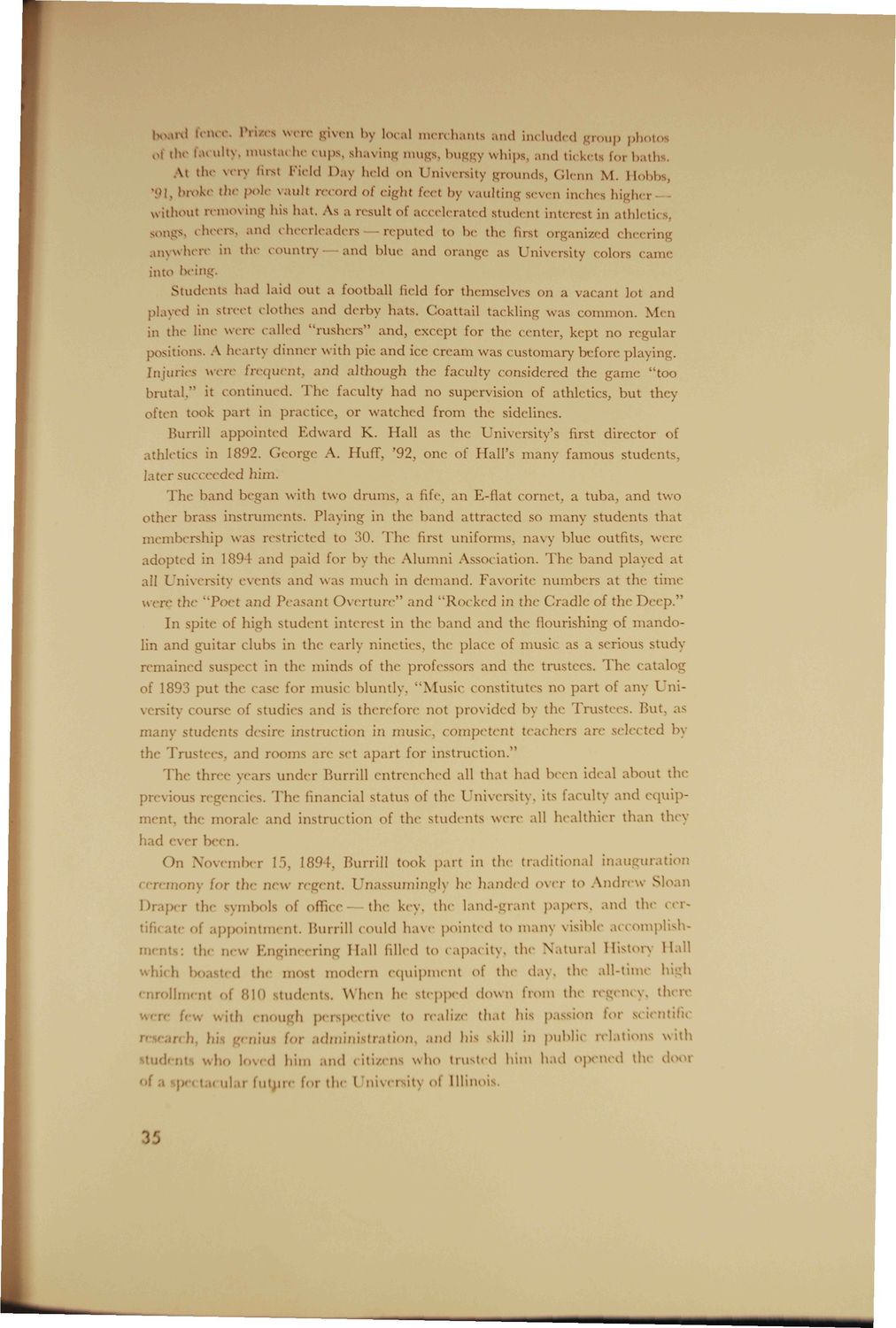| |
| |
Caption: Book - Illini Years
This is a reduced-resolution page image for fast online browsing.

EXTRACTED TEXT FROM PAGE:
board fence, Prwcs were given by local merchants and included group photos o| the faculty, mustache cups, shaving mugs, buggy whips, and tickets for baths. At the very first Field Day held on University grounds, Glenn M. Hobbs, -01, broke the pole vault record of eight feet by vaulting seven inches higher- without removing his hat. As a result of accelerated student interest in athletics, songs, cheers, and cheerleaders — reputed to be the first organized cheering anywhere in the countr) and blue and orange as University colors came into being. Students had laid out a football field for themselves on a vacant lot and played in street clothes A\K\ derby hats. Coattail tackling was common. Men in the line were called "rushers" and, except for the center, kept no regular positions. A hearty dinner with pic and ice cream was customary before playing. Injuries were frequent, and although the faculty considered the game "too brutal," it continued. The faculty had no supervision of athletics, but they often took part in practice, or watched from the sidelines. burrill appointed Edward K. Hall as the University's first director of athletics in 1892. George A. Huff, '92, one of Hall's many famous students, later succeeded him. The band began with two drums, a fife, an E-llat cornet, a tuba, and two other brass instruments. Playing in the band attracted so many students that membership was restricted to 30. The first uniforms, navy blue outfits, were adopted in 189-1 and paid for In- the Alumni Association. The band played at all University events and was much in demand. Favorite numbers at the time were the "Poet and Peasant Overture" and "Rocked in the Cradle of the Dee])." In spite of high student interest in the band and the flourishing of mandolin and guitar clubs in the early nineties, the place of music as a serious study remained suspect in the minds of the professors and the trustees. The catalog of 1893 put the case for music bluntly, "Music constitutes no part of any University course oi studies and is therefore not provided by the Trustees. But, as many students desire instruction in music, competent teachers are selected by the Trustees, and rooms are set apart for instruction." The three years under Burrill entrenched all that had been ideal about tin* previous re :ncies. The financial status of the University, its faculty and equipment, the morale and instruction of the students were all healthier than thev had ever been. On November 1"). 1891. Burrill took part in the traditional inauguration Temony for the new regent. Unassumingly he handed over to Andrew Sloan Draper th< symbols of office — the key, the land-grant papers, and the cci tificatc of appointment. Burrill could have pointed to man) visible accomplishthe new Engineering 11.ill filled to capacity, the Natural History Hall hich boasted the most modem equipment of the day, the all-time high llm'-nt of 810 students. When he stepped down from the i em \ . there :'•.'. with enough perspective to realize that his passion tor s ntit < hi niu for administration, and his skill in public relations with udents who loved him and citizens \sh<» trusted him had opened the door ol p .< ul.ii liitnir foi tin t niv< i it\ ol Illinois. s
| |